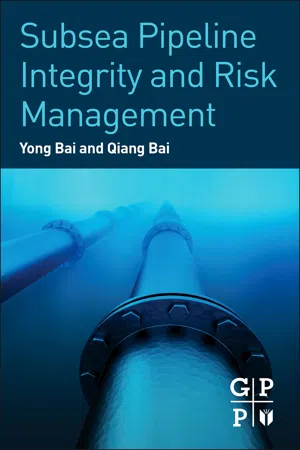
- 428 pages
- English
- ePUB (mobile friendly)
- Available on iOS & Android
About this book
Subsea repairs and inspection are costly for petroleum and pipeline engineers and proper training is needed to focus on ensuring system strength and integrity. Subsea Pipeline Integrity and Risk Management is the perfect companion for new engineers who need to be aware of the state-of-the-art techniques. This handbook offers a "hands-on" problem-solving approach to integrity management, leak detection, and reliability applications such as risk analysis.Wide-ranging and easy-to-use, the book is packed with data tables, illustrations, and calculations, with a focus on pipeline corrosion, flexible pipes, and subsea repair. Reliability-based models also provide a decision making tool for day-to-day use. Subsea Pipeline Integrity and Risk Management gives the engineer the power and knowledge to protect offshore pipeline investments safely and effectively.- Includes material selection for linepipe, especially selection of standard carbon steel linepipe- Covers assessment of various types of corrosion processes and definition of anti-corrosion design against internal as well as external corrosion- Gives process and flow assurance for pipeline systems including pipeline integrity management
Frequently asked questions
- Essential is ideal for learners and professionals who enjoy exploring a wide range of subjects. Access the Essential Library with 800,000+ trusted titles and best-sellers across business, personal growth, and the humanities. Includes unlimited reading time and Standard Read Aloud voice.
- Complete: Perfect for advanced learners and researchers needing full, unrestricted access. Unlock 1.4M+ books across hundreds of subjects, including academic and specialized titles. The Complete Plan also includes advanced features like Premium Read Aloud and Research Assistant.
Please note we cannot support devices running on iOS 13 and Android 7 or earlier. Learn more about using the app.
Information
Corrosion and Corroded Pipelines
Abstract
Keywords
Corroded Pipeline; Defect Prediction Model; Reliability Based Design; Re-qualification Criteria; Sour Corrosion; Sweet Corrosion1. Introduction
2. Corrosion Defect Prediction
Introduction
Table of contents
- Cover image
- Title page
- Table of Contents
- Copyright
- Foreword
- Preface
- Part 1 Pipeline Integrity Management
- Part 2 Risk and Reliability Applications
- Index